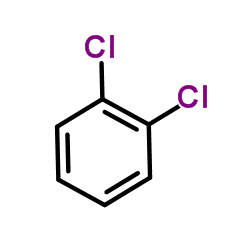1,2-Dichlorobenzene

1,2-Dichlorobenzene structure
|
Common Name | 1,2-Dichlorobenzene | ||
|---|---|---|---|---|
| CAS Number | 95-50-1 | Molecular Weight | 147.002 | |
| Density | 1.3±0.1 g/cm3 | Boiling Point | 180.5±0.0 °C at 760 mmHg | |
| Molecular Formula | C6H4Cl2 | Melting Point | -15 °C | |
| MSDS | Chinese USA | Flash Point | 65.6±0.0 °C | |
| Symbol |



GHS02, GHS06, GHS08 |
Signal Word | Danger | |
|
Highly Conductive Aromatic Functionalized Multi-Walled Carbon Nanotube for Inkjet Printable High Performance Supercapacitor Electrodes.
PLoS ONE 10 , e0131475, (2015) We report the functionalization of multiwalled carbon nanotubes (MWCNT) via the 1,3-dipolar [3+2] cycloaddition of aromatic azides, which resulted in a detangled CNT as shown by transmission electron microscopy (TEM). Carboxylic moieties (-COOH) on aromatic a... |
|
|
QSPR modeling of octanol/water partition coefficient for vitamins by optimal descriptors calculated with SMILES.
Eur. J. Med. Chem. 43 , 714-40, (2008) Simplified molecular input line entry system (SMILES) has been utilized in constructing quantitative structure-property relationships (QSPR) for octanol/water partition coefficient of vitamins and organic compounds of different classes by optimal descriptors.... |
|
|
Plasmonic ag@oxide nanoprisms for enhanced performance of organic solar cells.
Small 11 , 2454-62, (2015) Localized surface plasmon resonance (LSPR), light scattering, and lowering the series resistance of noble metal nanoparticles (NPs) provide positive effect on the performance of photovoltaic device. However, the exciton recombination on the noble metal NPs ac... |
|
|
Preparation, Structural Determination, and Characterization of Electronic Properties of Bis-silylated and Bis-germylated Lu3 N@Ih -C80.
Chemistry 21 , 16411-20, (2015) Bis-silylated and bis-germylated derivatives of Lu3 N@Ih -C80 (3, 4, 5) were successfully synthesized by the photochemical addition of disiliranes 1 a, 1 b or digermirane 2, and fully characterized by spectroscopic, electrochemical, and theoretical studies. I... |
|
|
Application of optimized dispersive liquid-liquid microextraction for determination of melatonin by HPLC-UV in plasma samples.
J. Chromatogr. B. Analyt. Technol. Biomed. Life Sci. 960 , 1-7, (2014) Melatonin (N-acetyl-3-(2-aminoethyl)-5-methoxyindole) is biologically active as a neurohormone and antioxidant agent. The optimized dispersive liquid-liquid microextraction (DLLME) followed by high-performance liquid chromatography-ultra violet detection (HPL... |
|
|
Microfluidic Crystal Engineering of π-Conjugated Polymers.
ACS Nano 9 , 8220-30, (2015) Very few studies have reported oriented crystallization of conjugated polymers directly in solution. Here, solution crystallization of conjugated polymers in a microfluidic system is found to produce tightly π-stacked fibers with commensurate improved charge ... |
|
|
Comparison of air-agitated liquid-liquid microextraction and ultrasound-assisted emulsification microextraction for polycyclic aromatic hydrocarbons determination in hookah water.
J. Sep. Sci. 38 , 2496-502, (2015) In this work, two disperser-free microextraction methods, namely, air-agitated liquid-liquid microextraction and ultrasound-assisted emulsification microextraction are compared for the determination of a number of polycyclic aromatic hydrocarbons in aqueous s... |
|
|
Understanding Solidification of Polythiophene Thin Films during Spin-Coating: Effects of Spin-Coating Time and Processing Additives.
Sci. Rep. 5 , 13288, (2015) Spin-coating has been used extensively in the fabrication of electronic devices; however, the effects of the processing parameters have not been fully explored. Here, we systematically characterize the effects of the spin-coating time on the microstructure ev... |
|
|
Olefin polymerisation catalysts: when perfection is not enough.
Dalton Trans. 44 , 12304-11, (2015) Despite decades of thorough mechanistic investigations, it is still hard to predict the activity of a novel olefin polymerisation catalyst, even when the precursor is a well-defined molecular entity. In the present study, we highlight the crucial importance o... |
|
|
Revealing the working mechanism of polymer photodetectors with ultra-high external quantum efficiency.
Phys. Chem. Chem. Phys. 17 , 30712-20, (2015) We report polymer photodetectors (PPDs) with an evident photomultiplication (PM) phenomenon, based on a sandwich structure ITO/PEDOT:PSS/P3HT:PC71BM(100:1)/Al. A similar device structure has been reported in our previous work, showing great potential as a new... |